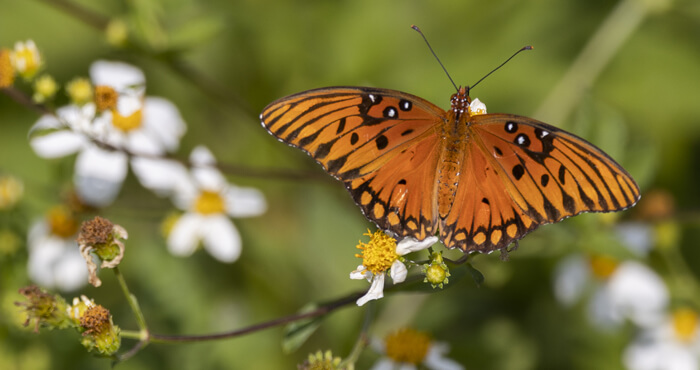
Sustainable Fire Ant Control
The red imported fire ant is a well-known and troublesome pest throughout the southeastern United States. This invasive species is aggressive, and their painful stings can injure both humans and animals. The nuisances and hazards of fire ants cause many people to seek a “quick-fix” control strategy.
The high demand for a fast solution has led to the development of many “home remedies” and practices advertised as alternatives to pesticide treatments. Most of these have not been scientifically tested, and many have proven ineffective. But, some fire ant control efforts do hold promise for sustainable solutions to manage fire ants.
Fire Ant Ecology Basics
Red imported fire ants prefer open, sunny areas such as pastures, crop fields, and lawns. They will form either single-queen or multi-queen colonies. Multi-queen colonies are not territorial.
Fire ant nests usually take the form of large dirt mounds, but ants will also nest in rotting logs; around trees; under pavement and buildings; indoors; or inside electrical equipment and utilities, which sometimes causes short circuits. Fire ant nests will not have a single nest entry, but rather, several entrances under the mound. When the nest is disturbed, many fire ants will swarm out to attack the intruder.
Fire ants are omnivorous. They eat plants, insects, oils, and sugars, but they are only able to ingest liquids. Larvae break down solid food into liquids for fire ants by regurgitating digestive enzymes onto the food.
Sustainable Fire Ant Control Methods
To eliminate a colony, the queen must be killed; in multi-queen colonies, all queens must be killed. Even if the queen is killed, surviving ants may inhabit the mound or make a new mound until they die off.
Baits
Baits can be used as a broadcast or individual mound treatment. Conventional recommended treatments involve a “two step” process of broadcast bait treatments and individual mound treatments. But, broadcast baiting may be counterproductive because it can also decrease native ant populations that slow fire ant spread. If there are native ants in your treatment area, try using only individual mound treatments to prevent affecting non-target ant populations.
Least Toxic Pesticides
Hydramethylnon and sulfluramid kill ants by preventing them from converting food into energy.
Avermectin is derived from a soil fungus and inhibits nerve function. As a broadcast treatment it works like an insect growth regulator.
Insect growth regulators that reduce egg production and prevent worker ant development include fenoxycarb, methoprene, and pyriproxyfen. These treatments do not kill adult ants, so treated colonies will persist until workers die naturally.
Organic Insecticides
Commercially available organic products that contain ingredients such as boric acid or diatomaceous earth can kill ants, but their effectiveness to kill whole colonies has not been consistently demonstrated.
Some products available have ingredients that are derived from botanical sources, such as rotenone, nicotine sulfate, d-limonene, and pyrethrins.
Spinosad is another toxin that affects the nervous system. Spinosad is considered organic because it comes from a bacterial fermentation process and is then put into bait.
Look for products certified by OMRI (Organic Materials Review Institute).
Physical Treatments
Treatments for fire ant control may be more effective on sunny, cool mornings when the majority of ants and brood are closer to the surface of the mound.
Hot Water
Scalding water (190ºF-212ºF) has been used on mounds with an elimination success rate of 20%-60%. Slowly pour at least 3 gallons onto the mound, being careful to avoid getting burned. A mound may need several treatments to reach and kill the queen and brood. Hot water may injure plants near the mound.
Excavation
Fire ant mounds can be dug up and removed. Apply baby powder or talcum to shovel handles and the inside of the bucket to keep ants from crawling up and escaping or stinging you.
Mound Drench
Another fire ant treatment is a solution containing citrus oil. D-limonene, the natural component found in the oils of citrus peel, is toxic to fire ants and can be an effective ingredient to add to home remedies for active mounds.
Sample Low Pesticide Treatment Option
- (Optional) Broadcast a bait-formulated insecticide.
- At least 3 days after baiting (if applied), drench individual mounds with hot water.
- Excavate and/or reapply hot water to mounds that are still active. Repeat as necessary.
- (Optional) Semi- or annually broadcast a bait-formulated insecticide to suppress reinfestations.
Ineffective Treatments
Many home remedies and fire ant control devices have not been scientifically proven to reduce fire ant populations. Most of the time these treatments just disturb the mound or kill enough ants to cause the colony to relocate. If the queens are not killed, the colony will not be destroyed and will most likely establish itself in another nearby area.
The following are some popular “home remedies” that do not control fire ant populations:
- Club Soda. One myth is that pouring club soda onto mounds suffocates the colony. This method is ineffective and at most may only drown a few ants. This method has been promoted on the Internet along with an inaccurate statement that the method is recommended by Walter Reeves of the University of Georgia.
- Grits. Fire ants only ingest liquids, so the idea that they will eat the grits, swell, and then explode is false.
- Soap or wood ashes. These substances supposedly remove the wax layer that protects the ant’s body, which is not true.
- Shoveling mounds together. Multi-queen colonies are not territorial and this method is not even effective for single-queen colonies. Florida has multi-queen populations, so by following this ineffective method you risk increasing your fire ant problem.
Some “non-pesticide” treatments are harmful to the environment and dangerous to apply. These include gasoline or petroleum products, battery acid, bleach, ammonia, or other cleaning products.
Biological Fire Ant Control
One reason fire ants are such resilient and successful invaders is that they have little competition and no natural enemies in the United States. To try to counter this imbalance, scientists began releasing phorid flies from fire ants’ native South America in the 1990s. Phorid flies are a natural parasite of fire ants in their home range. These flies lay their eggs near the ants' heads. As the larvae develop, they eventually kill the ant host. The ants' head will fall off and serve as the capsules where the fly will develop into a new adult.
The USDA has released six species of phorid fly, including Pseudacteon cultellatus to help control workers in multi-queen colonies, to control fire ants in the southeastern U.S. All of the released species have been established. At least three have become widely established and expanded beyond their release sites.
UF/IFAS and USDA/ARS scientists, in collaboration with colleagues in several states, have researched other biological control methods, including the use of fungi. The Microsporidium Kneallhazia solenopsae, a pathogen that reduces fecundity of fire ant queens and can lead to colony mortality, has been established all over the southern U.S. and is helping to reduce the fire ant populations.
Unfortunately, no fire ant control method (with possibly the exception of biological control agents) will permanently eliminate ants from an area. Fire ants can quickly re-infest areas after treatment stops, and may even resurge with greater populations. Because successful fire ant management techniques and products differ across localities, be sure to speak with your county’s Extension agent for management tips and questions.
Resources
Other UF/IFAS Sites
- Gardening Solutions
- Entomology and Nematology Department
- Environmental Horticulture Department
- FAWN: Florida Automated Weather Network
- Florida-Friendly Landscaping™ Program
- Florida Master Gardener Program
- IPM Florida
- Pesticide Information Office
UF/IFAS Publications
State & Federal Agencies
- Florida Department of Agriculture and Consumer Services (FDACS)
- Florida Department of Environmental Protection (FDEP)
- Florida Energy Systems Consortium (FESC)
- U.S. Environmental Protection Agency (EPA)
- USDA Plant Hardiness Zone Map--U.S. National Arboretum
Organizations & Associations
- American Community Gardening Association
- American Horticultural Society
- Florida Native Plant Society
- Florida Nursery, Growers and Landscape Association (FNGLA)
- North American Native Plant Society
Other Sites & Publications
UF/IFAS Mobile Web Apps





.jpg)

.jpg)
